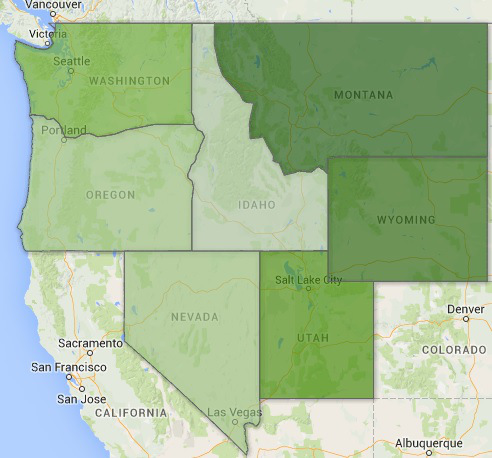Idaho and the Clean Power Plan: Easy goals, no clear solution
Published at
BOISE — Earlier this month, the federal government directed states to clean up their energy acts. While deadlines are far off, there is uncertainty about how Idaho should proceed — and how policymakers might react to recommendations.
What is the Clean Power Plan?
The Obama administration initiative lays out goals for nearly all states to reduce carbon emissions from power plants by 2030. Each of the goals is customized for state’s energy portfolios, and states have until September 2016 to submit plans or request an extension. For more information, click here.
What’s the outlook for Idaho?
On the surface, Idaho has it easy. With mostly hydroelectric and natural gas plants, the state is one of the lowest carbon producers in the United States. Idaho’s power plants emit less than half of the carbon Utah’s produce, and a third of Montana’s emissions. Our goals reflect those numbers; While Idaho’s carbon rate reduction goal is 10 percent, Montana’s is 47 percent. (Click on this interactive map by Idaho Reports associate producer Brad Iverson-Long to compare emissions and goals for Idaho and neighboring states.)
But there’s a downside to being one of the cleanest in the country. Moving forward, there isn’t much room for improvement — at least in the state’s energy sector. Because of the rule’s complexity and the possibility of partnerships with other states, it will take time before Idaho’s path forward is clear.
And it’s not yet clear if those goals take into account Idaho’s population growth projections. According to the Idaho Strategic Energy Alliance, Idaho’s electricity consumers are using electricity more efficiently, but “there is no doubt that additional electrical supply will be required to power Idaho’s future.” A request for comment from the Environmental Protection Agency wasn’t returned by deadline.
How will Idaho meet its goals?
Good question. There’s no plan right now, and there likely won’t be one for a while.
“It’s a 1,500 page rule,” said John Chatburn, administrator of the Idaho Governor’s Office of Energy Resources. “It’s not as simple as if it was all laid out in three pages (so we can) go look at it and intuitively know what is going to happen.
But there are options. Like all states, Idaho can choose to reduce carbon by either rate (which compares emitted carbon to each unit of energy plants produce) or mass (which would put a set cap on carbon emissions statewide), and the EPA has provided goals for each of those options. Idaho can also team up with neighboring states to tackle reductions together.
“States will have many opportunities under the plan to choose the type of plan that they want to proceed with,” said Janet McCabe, acting assistant administrator for the EPA’s Office of Air and Radiation, in an August 4 conference call.
There is a lot to sort through before settling on a plan, though. Chatburn said his office, the Department of Environmental Quality, and the Public Utilities Commission are working through the document to make sure they don’t miss anything.
In September, Idaho officials will meet with representatives from other states to discuss tentative plans, Chatburn said.
How will policymakers react?
Any recommendations will likely end up in front of the Idaho Legislature for approval — whether in the form of a proposed statutory change on emissions, or as a rule change under the DEQ’s existing air quality authority.
That could set Idaho up for a fight. Many in the Legislature don’t take kindly to federal directives, with some lawmakers introducing legislation in recent sessions to limit the EPA’s powers, or nullify the agency altogether.
House Energy, Environment and Technology Committee Chairman Jeff Thompson said he hadn’t looked into Idaho’s goals under the Clean Power Plan, but added any discussions involving regulations and the EPA often result in “good, vibrant discussions with passion.”
How will plans affect customers?
That depends on many things — and not all of those factors are in Idaho’s control.
Idaho imports a lot of its electricity. And while just one percent of Idaho’s in-state energy is generated from coal, about 35 percent of Idaho’s total energy is imported, and most of that comes from coal-fired plants in other states, according to the Idaho Strategic Energy Alliance.
Whatever changes those states make, it could result in rate hikes for consumers.
Last week, Ken Miller, energy program director of clean energy advocate Snake River Alliance, told Rocky Barker of the Idaho Statesman that while there may be cost increases from coal plants shutting down, “for Idaho, those costs will be more than offset through reduced electricity bills and the addition of new jobs and economic activity as Idaho stops exporting our energy dollars to other states in exchange for a new clean energy economy with expanded renewable energy and energy conservation investments.” Read more here.
Whatever those effects might be, they’re on Thompson’s radar.
“It’s going to be something we’ll be informing the committee of and having discussions about in committee,” Thompson said.
What about other sources of emissions?
They’re not addressed by the Clean Power Plan. And for most states, especially those reliant on coal plants, that makes sense.
But Idaho has other, much bigger contributors to its carbon emissions — namely, the agricultural industry and transportation, according to data from the World Resources Institute.
The EPA doesn’t regulate emissions — carbon or otherwise — from farms, confined animal feeding operations, and other ag facilities, and most counties in Idaho don’t produce enough pollution to require emissions testing under federal standards. So even if the state or private sector found ways to reduce emissions, it wouldn’t count for the Clean Power Plan goals.
Seth Ogilvie, Melissa Davlin, and Brad Iverson-Long contributed to this report.
This article was originally published on Idaho Reports. It is used here with permission.


